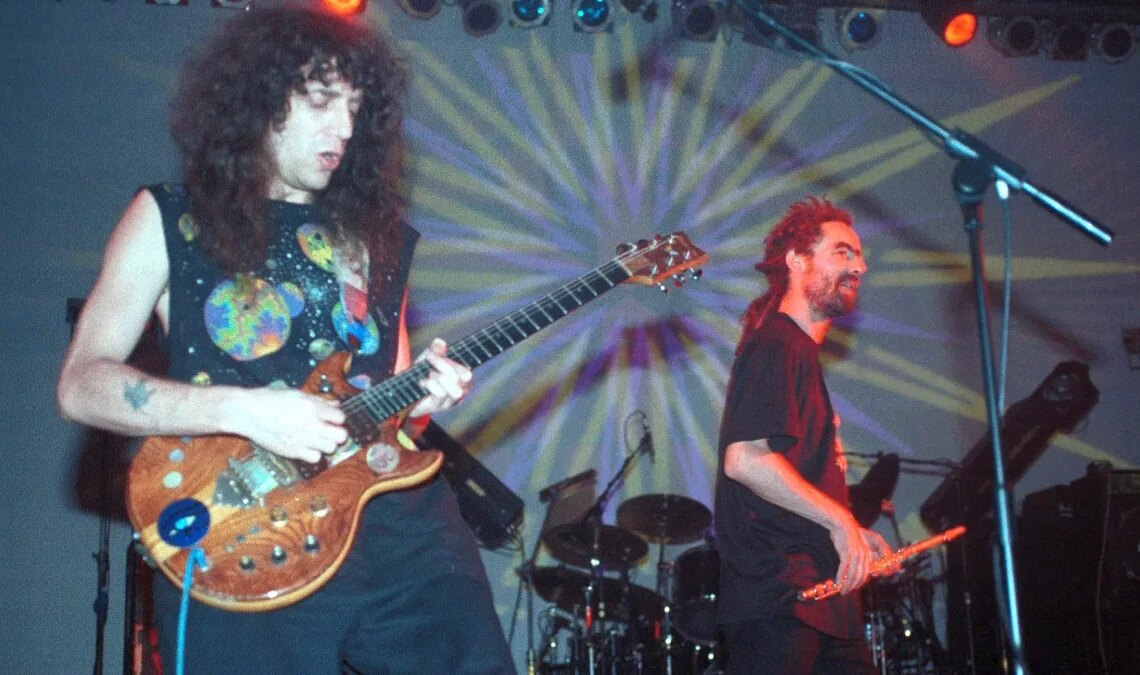When we think prog-rock, we usually think 70s, right? Maybe a little touch of 80s Genesis resurgence? But what about the oft-forgotten 90s? The 90s were overflowing with grunge bands, the fledgling riot grrrl movement, and hardcore rap rivalries. But there was still a place carved out for spacey, improvisational prog-rock. Here are three albums from the 90s that brought prog-rock greatness into the new decade.
‘Strangeitude’ by Ozric Tentacles
Strangeitude was the fourth album from British prog-rock outfit Ozric Tentacles, led consistently by Ed Wynne. The group overall was relatively successful despite never signing to a major label, preferring to exist within the niche independent and U.K. festival scenes before creating their own record label. Released in 1991, Strangeitude was one of the earlier albums on Dovetail Records.
The single “Sploosh!” reached the No. 7 spot on the U.K. Indie Chart, but retrospective reviews claim this album is more “down-to-earth” than other Ozric releases. For an album called Strangeitude, apparently, it wasn’t all that strange. Still, diehard prog-rock fans count this album as yet another example of the greatness that is Ozric Tentacles. Oh, despite one person’s admission that, even though Strangeitude is a delightful listen, “I can’t imagine why anyone would need more than one Ozric Tentacles album.”
‘The Sky Moves Sideways’ by Porcupine Tree
The Sky Moves Sideways was released in 1995, serving as Porcupine Tree’s first album in the U.S. Additionally, it was the first of Porcupine Tree’s works to feature an entire band, instead of artist Steven Wilson playing every instrument. While the U.S. edition has an altered tracklist (losing about six minutes of runtime), a remastered version in 2004 created an entirely new edition of the prog-rock juggernaut. The reissue runs roughly 109 minutes, and it notably includes “The Sky Moves Sideways (Alternate Version)” which imagined the entire album as a single 34-minute track.
Overall, The Sky Moves Sideways was well received by prog-rock critics. Many made comparisons to Pink Floyd’s Wish You Were Here, with the opening and closing tracks bookending the album as two halves of a complete piece. Because this album was the first with a full band, there was a sense of experimentation and maybe even hesitance compared to the previous album, Up The Downstair. A review from AllMusic noted this “as if the bandmembers were getting used to working with each other.”
‘Liquid Tension Experiment 2’ by Liquid Tension Experiment
Liquid Tension Experiment was formed as a supergroup by Mike Portnoy, adding Jordan Rudess, Tony Levin, and John Petrucci as members. Initially, Liquid Tension Experiment was an attempt to create something separate from his existing prog-metal band Dream Theater. But Portnoy ended up recruiting two of his regular bandmates anyway (Petrucci and Rudess).
Liquid Tension Experiment 2 was released in 1999, the same year that Rudess officially joined Dream Theater. After this, Portnoy explained there wouldn’t be a third LTE album due to similarities with Dream Theater. The group underwent lineup changes and reunions in the years following a hiatus. However, they’re active again as of 2021. But Liquid Tension Experiment 2 captured the essence of the group’s early spontaneous endeavors. The improvisations, call-and-response solos, and flurried guitar work make the album an out-of-body sonic experience, as described in detail in the band’s liner notes.
Photo by Ian Dickson/Redferns
The post 3 Spacey Prog-Rock Albums From the 90s You’ve Probably Never Heard appeared first on VICE.




